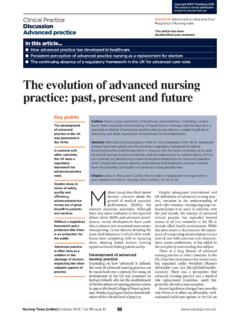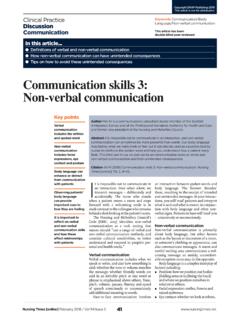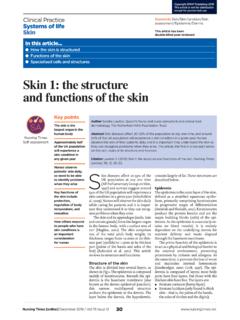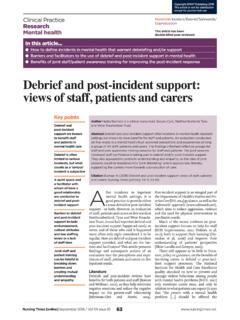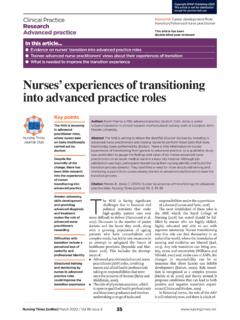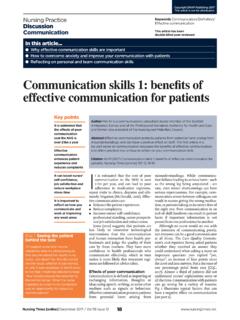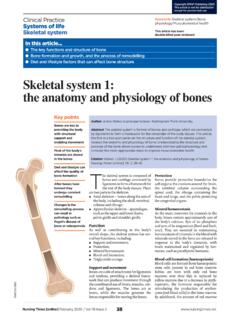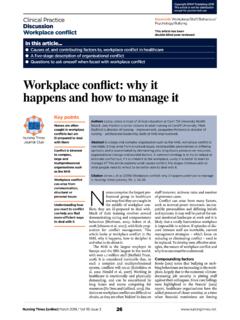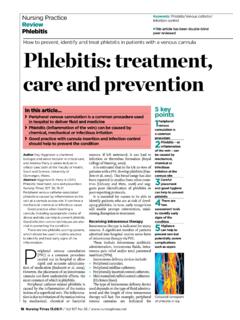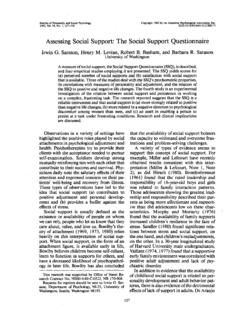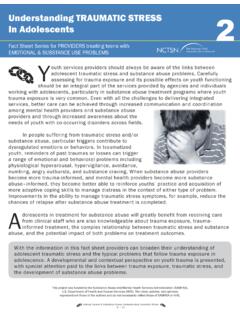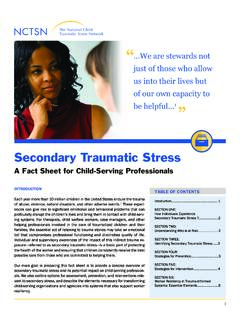Transcription of The importance of assessing pain in adults
1 12 Nursing Times / Vol 111 No 41 / : Adult/Assessment/Pain This article has been double-blind peer reviewedAuthor Amelia Swift is senior lecturer in nursing at the University of Swift A (2015) Pain management 3: The assessment of pain in adults . Nursing Times; 111: 41, affects patients physically and emotionally, so successfully managing the pain they experience is a key component of their recovery. This third article in a series on pain looks at why it is important to assess pain in adults and how this can best be done. The causes and symptoms of chronic and acute pain are detailed, along with the different assessment tools that can be used and for which patients they are is a personal experience, and every experience of it is unique.
2 It is not just a physical sensation but is bound up with an emo-tional response and an act of reasoning; this is why pain is known as a multidimen-sional experience (Fillingim et al, 2014). Pain also has physical and emotional con-sequences; it can make us lead to fatigue, irritability, depression or inability to carry out activities of daily living (Leadley et al, 2014). Chronic pain also affects social and economic wellbeing, restricting work and social activities (Morgan et al, 2011). Pain is difficult to explain and use of analogies is common (Schott, 2004).
3 For example, It feels like my head is in a vice immediately communicates what the patient is feeling, while This pain is killing me demonstrates the psycholog-ical impact of pain. Patients need to com-municate pain because they want others to know how they feel because that is 5 key points 1 Pain can be acute or chronic in nature 2 Pain assessments are crucial to ascertain the best treatment and monitor any underlying causal condition 3 Patients may not always volunteer information about the pain they are experiencing so may need to be asked about it 4 Various pain assessment tools exist to cater for patients different capabilities 5 Pain severity should be documented to track
4 Efficacy of treatments and interventions and patient recoverycomforting and elicits empathy and help (Buenaver et al, 2007). Health professionals want to understand patients pain because that will help them to diagnose the problem, select an effective treatment pro-gramme and monitor their progress. Purpose of pain assessment A pain assessment is conducted to: Detect and describe pain to help in the diagnostic process; Understand the cause of the pain to help determine the best treatment; Monitor the pain to determine whether the underlying disease or disorder is improving or deteriorating, and whether the pain treatment is content and scope of the assess-ment depends on its purpose and the type of pain.
5 Acute pain is caused by a short-lived pathological process, such as a sur-gical incision or a sprain. Provided this pain is treated and there is no nerve damage, it usually resolves as the body heals (Grichnik and Ferrante, 1991). Chronic pain lasts for a prolonged time at least three months (this is the time at which tissue healing should be complete) (Hughes, 2008). The term describes com-plex pains where there may have been a pathological trigger but, although healing has taken place, the pain continues for example, chronic low back pain.
6 Another type of chronic pain relates to ongoing pathological processes, such as osteoar-thritis, and to pains that are caused by damage to, or dysfunction of, the nervous system; this includes pains as diverse as post-stroke pain and diabetic neuropathy. In this Core elements of a pain assessment Tools to help patients self-report pain Common sites of referred painPain is a personal experience but may be difficult to communicate. It is vital that nurses know how best to assess it to ensure the optimal treatment is given The importance of assessing pain in adultsPhrases like my head feels like it s in a vice can help nurses get a sense of pain severity PArT 3 of 3.
7 PAiN mANAgemeNTNursing PracticeReviewPain managementCopyright EMAP Publishing 2015 This article is not for / Vol 111 No 41 / Nursing Times 13 For more articles on pain management, go to to identify an event that triggered it and the lack of an identifiable and treatable pathology can be worrying to them. Questions about onset of pain reveal what patients know or believe about what is happening to them. Their understanding can have a significant influence on their ability to cope, follow instructions and respond to treatment.
8 Taking chest pain as an example, many people associate this with myocardial infarction and there is evidence that, even when MI is ruled out, patients still experience fear, stress and a sense of loss of strength (Jerlock et al, 2005). The cause of painIn order to select the most appropriate treatment is necessary to identify the mechanism of injury (how it happened). Some key questions include: Is this pain related to tissue damage? This type of pain is called nociceptive pain, physiological pain, inflammatory pain and tissue damage pain.
9 It can be caused by direct trauma to the tissues (for example, burn, surgery, graze, sprain) or ongoing disease process (such as arthritis). It can be superficial (related to the skin and muscle), which is called somatic pain, or deep and related to the organs (for example, bowel, pancreas, heart), which is called visceral pain. Is this pain related to nerve damage or a disorder of the nerves or nervous system? This sort of pain is called neurogenic pain, neuropathic pain, central pain and phantom pain. It can be caused by direct trauma to the nerves due to compression, cutting or chemical insult; malfunction or disease-related damage of the nerves (such as diabetic neuropathy, alcoholic neuropathy unable to participate in the assessment process, it is recommended that a tool specifically designed to assess pain in non-verbal older adults is used: a comprehensive review of 17 of these can be found on the City of Hope Pain and Palliative Care Resource Center s website ( ).)
10 Health professionals should not assume that a patient cannot participate in a pain assessment. People with dementia can often use self-report pain scales but they may need to be re-taught how to do so each time (Kaasalainen et al, 2013). Almost universally, patients change their normal behaviour when they are in pain, so knowing individual patients and their normal demeanour is vital. Common elements of the assessmentCore information is common to all pain assessments.
